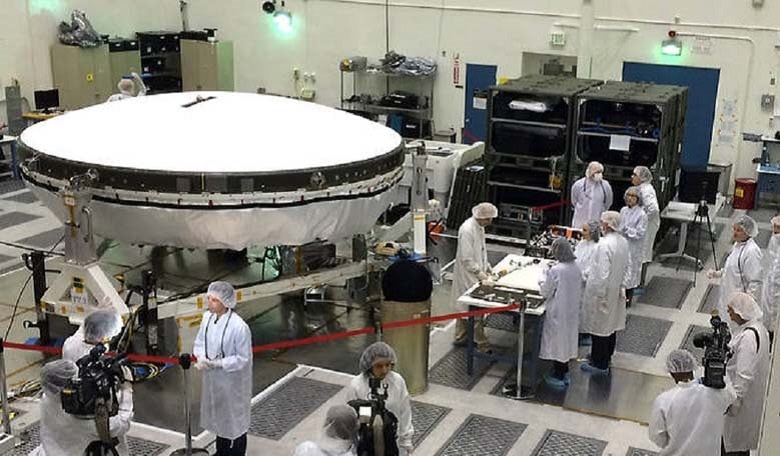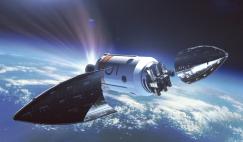NASA's Low-Density Supersonic Decelerator (LDSD) project will be flying a rocket-powered, saucer-shaped test vehicle into near-space from the Navy's Pacific Missile Range Facility on Kauai, Hawaii, in June.
Media were on hand at NASA's Jet Propulsion Laboratory, Pasadena, California, on March 31 to witness one of the final tests that a LDSD test vehicle will undergo before shipping out to Hawaii. During the "spin table test," the 15-foot-wide, 7,000-pound test vehicle was spun up to 30 rpm to check its balance.
In mid-April, the vehicle will be flown to Kauai. During the June experimental flight test, a balloon will carry the test vehicle from the naval facility to an altitude of about 120,000 feet (36 kilometers). There, over the Pacific, it will be dropped and its booster rocket will kick in and carry it to 180,000 feet (55 kilometers), accelerating to Mach 4. Once in the very rarified air high above the Pacific, the saucer will begin a series of automated tests of two breakthrough technologies.
The supersonic inflatable aerodynamic decelerator (SIAD-R) -- essentially an inflatable doughnut that increases the vehicle's size and, as a result, its drag -- will be deployed at about Mach 3.8. It will quickly slow the vehicle to Mach 2.5 where the parachute -- the largest supersonic parachute ever flown -- will deploy. About 45 minutes later, the saucer is expected to make a controlled landing onto the Pacific Ocean off Hawaii.
The upper layers of Earth's stratosphere are the most similar environment available to match the properties of the thin atmosphere of Mars. The LDSD mission developed this test method to ensure the best prospects for effective testing of the new and improved landing technologies here on Earth.
Those interested in watching the test can find an archived copy of today's LDSD Ustream event at:
http://www.ustream.tv/recorded/60585512
The LDSD crosscutting demonstration mission will test breakthrough technologies that will enable large payloads to be safely landed on the surface of Mars, or other planetary bodies with atmospheres, including Earth. The technologies will not only enable landing of larger payloads on Mars, but also allow access to much more of the planet's surface by enabling landings at higher-altitude sites.
More information about the LDSD space technology demonstration mission is online at:
http://www.nasa.gov/mission_pages/tdm/ldsd/
The LDSD mission is part of NASA's Space Technology Mission Directorate, which is innovating, developing, testing and flying hardware for use in future missions. NASA's technology investments provide cutting-edge solutions for our nation's future. For more information about the directorate, visit:











